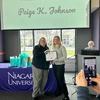The non-native invasive insect, Hemlock Woolly Adelgid (HWA; Adelges tsugae), was found this winter on about 50 hemlock trees in the campus woodlot adjacent to Ring Road.
The infestation is believed to be the first in Chautauqua County. HWA causes little damage to trees in its native range in Japan due to natural enemies and resistance by Japanese hemlock. In the U.S., however, HWA’s recent introduction has already devastated hemlock stands throughout the southern Appalachians.Professor Jonathan Titus of the Department of Biology noted, “It is critical that the infestation in the campus woodlot be controlled so that it does not spread and the hemlock forests are maintained while scientists develop effective biocontrol agents. This will help Fredonia avoid becoming the source of a spreading infestation.”
HWA is a tiny aphid which feeds on sap at the base of hemlock needles causing needle loss and preventing trees from producing new buds. Infestations typically kill mature trees in four to ten years. During the winter, HWA produce noticeable white cottony ovisacs, containing up to 300 eggs, which allow an efficient means to identify infested hemlocks.
Hemlocks, a common and an integral part of New York’s forests, are critical for numerous wildlife species. Locally, Canadaway Creek was named after the tree. In the region, the finest remaining old growth hemlock stand is present within the College Lodge property, but HWA has not yet been detected there. However, regular monitoring of the property will be necessary to ensure early detection and response in the event that it is introduced.
Fredonia is working with the New York State Department of Environmental Conservation to develop a control plan.



